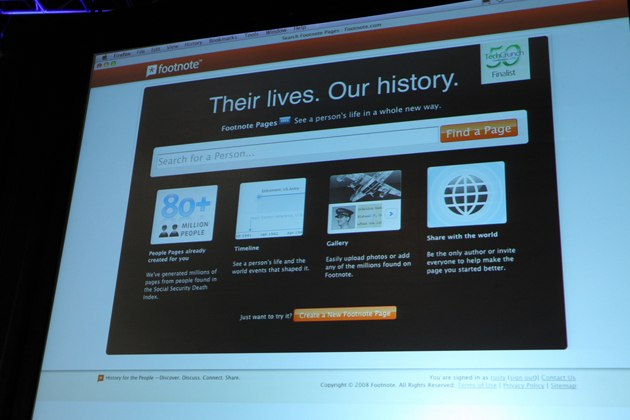In what was easily the most morbid presentation of TechCrunch50, we were introduced to a new kind of social network: Footnote, a place for dead people.
Of course, the site isn’t going to be filled with the interactions of the waking dead. Instead, it’s meant as a social memory book, asking users to upload old photos, share stories, and fill in a timeline of their friend or family member’s life. You can also tie profiles to each other, detailing how each person knew other members.

The site also offers a database of 43 million images, birth and death records, and newspapers, which users can search through to annotate each profile (there’s even a Facebook-esque tagging feature for photos).
At launch the site features 80 million profiles automatically generated for the deceased using publicly available death records. This disturbed some of the judges, but Footnote says that the information is available to the public anyway.
Watch the video of Footnote’s presentation here.
Expert Panelists
Jeff Weiner – Interesting technology. I think key question is whether this a set of functionality that would be used in an a social network or genealogy site – it feels like an activity chain in a genealogy site. You bring a lot of interesting functionality.. There are real time memorials created in social networks. This very information driven and there’s something to be said for celebrating one’s life in death. Which didn’t come across during the presentation. One missing thing is music.
Don Dodge- Another amazing website, you’ve done a great job putting this together. The living memorials thing, I’ve seen several site that allow you to create a living memorial, that’s one piece of the market, you’ve got elements of LinkedIn and Facebook. How do you focus and monetize?
Footnote – We are currently a subscription website. These 43 million images already digitized require a subscription to access. We can do a pay per view, monthly, or annual subscription fee. While the 80 million profiles from public data can be done by someone else, the images are hard to replicate.. We’re the only place you can find those on the internet.
Sean Parker – How do you get distribution? A lot of companies in the social networking space think that somehow they will build awareness. I don’t think social networking model exists. it’s hard enough to get all these people when they’re alive. Niche socal networks don’t tend to work very well. And it’s the community functionality, not the social grpah.
Loic Le Meur – i like the idea of social software for death because there are low customer service requests… Honestly, I find it disturbing.. i wouldn’t like to have my family exposed, can I opt out for my family?
Footnote – These are publicly available records, so if you have a social security numbe it’s already out there. And the people who would be building a profile would be you or someone who knew them.
Loic Le Meur – I would hate to see a blank profile with my father’s name
when he (and I) can’t control it. You may want to control access by family.
Sean Parker – To Jeff’s point this is a market with a shelf life. There are already big social networks, and when someone passes away, all of these profiles will exist, they’ll get put into this memorial state.. you wind up with a lot of dead people on these networks.. these networks will have data much richer than you provide
Loic Le Meur- Monetizing my family… I have a problem with that.
Jeff Weiner – I don’t know if anyone wants to be remembered as a footnote
Footnote – The purpose was to leave your footnote to history
